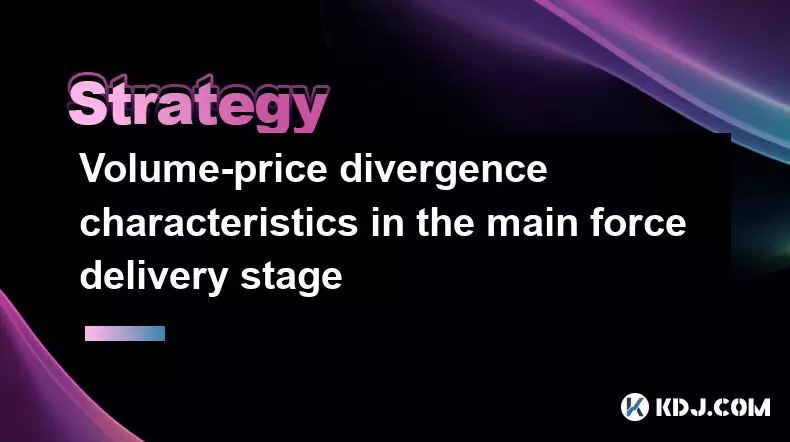-
 bitcoin
bitcoin $122090.672462 USD
1.59% -
 ethereum
ethereum $4493.758974 USD
0.56% -
 xrp
xrp $3.033145 USD
0.65% -
 tether
tether $1.000629 USD
0.00% -
 bnb
bnb $1169.854250 USD
7.07% -
 solana
solana $230.954786 USD
-0.19% -
 usd-coin
usd-coin $0.999785 USD
0.00% -
 dogecoin
dogecoin $0.256108 USD
-1.12% -
 tron
tron $0.342333 USD
-0.12% -
 cardano
cardano $0.859632 USD
-0.10% -
 hyperliquid
hyperliquid $48.932146 USD
-2.25% -
 chainlink
chainlink $22.345466 USD
-1.29% -
 ethena-usde
ethena-usde $1.000217 USD
-0.03% -
 avalanche
avalanche $31.203456 USD
1.93% -
 sui
sui $3.579145 USD
1.05%
Volume-price divergence characteristics in the main force delivery stage
Volume-price divergence in crypto markets signals trend shifts; rising prices with declining volume may indicate main force distribution, suggesting a potential reversal.
Jun 01, 2025 at 02:49 am

Introduction to Volume-Price Divergence
Volume-price divergence is a critical concept in the analysis of cryptocurrency markets, particularly during the main force delivery stage. This stage is when significant market players, often referred to as 'whales' or 'main forces,' begin to distribute their holdings to retail investors. Understanding the characteristics of volume-price divergence can help traders identify potential trend reversals or continuations, thus making more informed trading decisions.
What is Volume-Price Divergence?
Volume-price divergence occurs when the price of a cryptocurrency moves in one direction while the trading volume moves in the opposite direction. For instance, if the price of a cryptocurrency is rising, but the trading volume is decreasing, this indicates a bullish divergence. Conversely, if the price is falling while the volume is increasing, this is known as a bearish divergence. These divergences can signal that the current trend may be losing momentum or that a reversal might be imminent.
Importance of Volume-Price Divergence in the Main Force Delivery Stage
During the main force delivery stage, volume-price divergence becomes particularly significant. This stage is characterized by large holders selling their positions to smaller investors. A key characteristic to watch for is when the price continues to rise, but the volume starts to decline. This bullish divergence can indicate that the main force is beginning to distribute their holdings, and the upward momentum may soon wane.
Identifying Volume-Price Divergence
To identify volume-price divergence, traders need to closely monitor both price movements and trading volumes. Here are the steps to effectively identify this phenomenon:
- Select a reliable charting platform: Use a platform that provides accurate and real-time data on both price and volume.
- Plot the price chart: Choose the appropriate timeframe based on your trading strategy. Daily or weekly charts are often used for long-term analysis.
- Add a volume indicator: Most charting platforms allow you to add a volume indicator below the price chart.
- Analyze the trends: Look for instances where the price trend and volume trend are moving in opposite directions.
- Confirm with other indicators: Use additional technical indicators, such as the Relative Strength Index (RSI) or Moving Average Convergence Divergence (MACD), to confirm the divergence signals.
Characteristics of Bullish Divergence in the Main Force Delivery Stage
Bullish divergence in the main force delivery stage often manifests as a rising price accompanied by declining volume. This indicates that the buying pressure is decreasing even as the price continues to rise. The key characteristics include:
- Gradual price increase: The price continues to climb, but at a slower pace.
- Declining volume: Trading volume decreases as the price rises, suggesting that fewer buyers are entering the market.
- Resistance levels: The price may approach or reach previous resistance levels, but the volume fails to confirm the breakout.
- Potential for reversal: The divergence suggests that the upward trend may soon reverse, as the main force begins to sell off their holdings.
Characteristics of Bearish Divergence in the Main Force Delivery Stage
Bearish divergence in the main force delivery stage is characterized by a falling price with increasing volume. This indicates that the selling pressure is intensifying even as the price continues to decline. The key characteristics include:
- Steady price decline: The price continues to fall, often accelerating as the volume increases.
- Increasing volume: Trading volume rises as the price falls, suggesting that more sellers are entering the market.
- Support levels: The price may approach or break through previous support levels, with the volume confirming the breakdown.
- Potential for further decline: The divergence suggests that the downward trend may continue, as the main force accelerates their distribution.
Using Volume-Price Divergence for Trading Decisions
Traders can use volume-price divergence to make informed trading decisions during the main force delivery stage. Here are some strategies:
- Entry points: Look for bullish divergence as a potential entry point for long positions. If the price is rising but volume is declining, it may be a good time to enter before a possible reversal.
- Exit points: Use bearish divergence as a signal to exit long positions or enter short positions. If the price is falling but volume is increasing, it may be wise to exit or short before the trend worsens.
- Stop-loss orders: Place stop-loss orders based on the divergence signals to manage risk effectively. For instance, if you enter a long position based on bullish divergence, set a stop-loss below a key support level.
- Confirmation with other indicators: Always confirm volume-price divergence signals with other technical indicators to increase the reliability of your trading decisions.
Real-World Examples of Volume-Price Divergence
To better understand volume-price divergence in the main force delivery stage, let's look at a couple of real-world examples:
- Example 1: Bitcoin (BTC) in 2021: In the first half of 2021, Bitcoin experienced a significant bull run, reaching an all-time high. However, as the price continued to rise, the trading volume began to decline. This bullish divergence suggested that the main force was starting to distribute their holdings, and indeed, a correction followed soon after.
- Example 2: Ethereum (ETH) in 2018: During the bear market of 2018, Ethereum saw a steady decline in price. However, as the price fell, the trading volume increased significantly. This bearish divergence indicated that the main force was accelerating their distribution, leading to further declines in the price.
Frequently Asked Questions
Q1: Can volume-price divergence be used in other stages of the market cycle?Yes, volume-price divergence can be used in other stages of the market cycle, such as the accumulation and markup stages. However, its significance and interpretation may vary depending on the specific stage and market conditions.
Q2: How reliable is volume-price divergence as a trading signal?Volume-price divergence can be a reliable trading signal when used in conjunction with other technical indicators. It is important to confirm divergence signals with additional tools to increase the probability of successful trades.
Q3: Are there any tools or software specifically designed to identify volume-price divergence?While there are no tools specifically designed to identify volume-price divergence, most charting platforms offer volume indicators and allow users to plot price and volume data on the same chart. Traders can use these platforms to manually identify divergence patterns.
Q4: How does volume-price divergence differ from other technical indicators?Volume-price divergence focuses on the relationship between price and volume, whereas other technical indicators may focus solely on price or other market factors. It provides unique insights into market dynamics by highlighting potential discrepancies between price movements and trading volume.
Disclaimer:info@kdj.com
The information provided is not trading advice. kdj.com does not assume any responsibility for any investments made based on the information provided in this article. Cryptocurrencies are highly volatile and it is highly recommended that you invest with caution after thorough research!
If you believe that the content used on this website infringes your copyright, please contact us immediately (info@kdj.com) and we will delete it promptly.
- BlockDAG, DOGE, HYPE Sponsorship: Crypto Trends Shaping 2025
- 2025-10-01 00:25:13
- Deutsche Börse and Circle: A StableCoin Adoption Powerhouse in Europe
- 2025-10-01 00:25:13
- BlockDAG's Presale Buzz: Is It the Crypto to Watch in October 2025?
- 2025-10-01 00:30:13
- Bitcoin, Crypto, and IQ: When Genius Meets Digital Gold?
- 2025-10-01 00:30:13
- Stablecoins, American Innovation, and Wallet Tokens: The Next Frontier
- 2025-10-01 00:35:12
- NBU, Coins, and Crypto in Ukraine: A New Yorker's Take
- 2025-10-01 00:45:14
Related knowledge

Practical parameter settings for a Bitcoin multi-timeframe moving average system
Sep 18,2025 at 10:54pm
Optimizing Timeframe Combinations for Bitcoin Trading1. Selecting appropriate timeframes is crucial when building a multi-timeframe moving average sys...

How can I filter out false breakouts in Dogecoin high-frequency trading?
Sep 22,2025 at 01:00am
Understanding False Breakouts in Dogecoin Trading1. A false breakout occurs when Dogecoin's price appears to move beyond a defined support or resistan...

Techniques for identifying tops and bottoms in the Bitcoin on-chain NVT model
Sep 20,2025 at 07:54pm
Understanding the NVT Model in Bitcoin Analysis1. The Network Value to Transactions (NVT) ratio is often described as the 'P/E ratio' of the cryptocur...

What does the surge in open interest in Bitcoincoin futures mean?
Sep 20,2025 at 11:18pm
Understanding the Surge in Dogecoin Futures Open Interest1. A surge in open interest within Dogecoin futures indicates a growing number of active cont...

How can I use the Ethereum USDT premium to gauge market sentiment?
Sep 18,2025 at 11:55pm
Understanding the Ethereum USDT Premium1. The Ethereum USDT premium refers to the price difference between USDT (Tether) traded on Ethereum-based plat...

What should I do if Ethereum staking yields decline?
Sep 20,2025 at 06:18am
Understanding the Causes Behind Declining Ethereum Staking Yields1. The Ethereum network transitioned to a proof-of-stake consensus mechanism with the...

Practical parameter settings for a Bitcoin multi-timeframe moving average system
Sep 18,2025 at 10:54pm
Optimizing Timeframe Combinations for Bitcoin Trading1. Selecting appropriate timeframes is crucial when building a multi-timeframe moving average sys...

How can I filter out false breakouts in Dogecoin high-frequency trading?
Sep 22,2025 at 01:00am
Understanding False Breakouts in Dogecoin Trading1. A false breakout occurs when Dogecoin's price appears to move beyond a defined support or resistan...

Techniques for identifying tops and bottoms in the Bitcoin on-chain NVT model
Sep 20,2025 at 07:54pm
Understanding the NVT Model in Bitcoin Analysis1. The Network Value to Transactions (NVT) ratio is often described as the 'P/E ratio' of the cryptocur...

What does the surge in open interest in Bitcoincoin futures mean?
Sep 20,2025 at 11:18pm
Understanding the Surge in Dogecoin Futures Open Interest1. A surge in open interest within Dogecoin futures indicates a growing number of active cont...

How can I use the Ethereum USDT premium to gauge market sentiment?
Sep 18,2025 at 11:55pm
Understanding the Ethereum USDT Premium1. The Ethereum USDT premium refers to the price difference between USDT (Tether) traded on Ethereum-based plat...

What should I do if Ethereum staking yields decline?
Sep 20,2025 at 06:18am
Understanding the Causes Behind Declining Ethereum Staking Yields1. The Ethereum network transitioned to a proof-of-stake consensus mechanism with the...
See all articles










































































